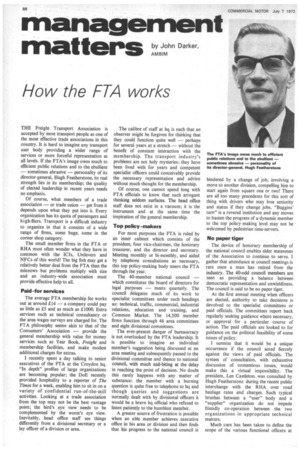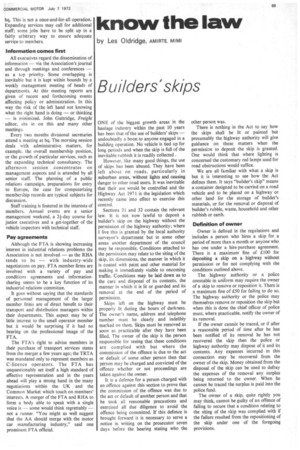nrianagemen matters
Page 90

Page 91

If you've noticed an error in this article please click here to report it so we can fix it.
by John Darker,
AMBIM
How the ETA works
THE Freight Transport Association is accepted by most transport people as one of the most effective trade associations in this country. It is hard to imagine any transport user body providing a wider range of services or more forceful representation at all levels. If the FTA's image owes much to efficient public relations and to the ebullient — sometimes abrasive — personality of its director-general, Hugh Featherstone, its real strength lies in its membership; the quality of elected leadership in recent years needs no emphasis.
' Of course, what members of a trade association — or trade union — get from it depends upon what they put into it. Every organization has its quota of passengers and high-fliers. Transport is a difficult industry to organize in that it consists of a wide range of firms, some huge, some in the corner shop category.
The small member firms in the FTA or RHA must often wonder what they have in common with the ICIs, Unilevers and NFCs of this world! The big fish may get a relatively better deal from the FTA than the minnows but problems multiply with size and an industry-wide association must provide effective help to all.
Paid-for services The average FTA membership fee works out at around £14 — a company could pay as little as £5 and as much as £1000. Extra services such as technical consultancy or the area wages surveys are charged for. The FTA philosophy seems akin to that of the Consumers' Association — provide the general membership with value for money services such as Year Book, Freight and membership facilities, and make modest additional charges for extras.
I recently spent a day talking to senior executives of the FTA at the Croydon hq. "In depth" profiles of large organizations are becoming popular; the DoE recently provided hospitality to a reporter of The Times for a week, enabling him to sit in on a variety of confidential run-of-the-mill activities. Looking at a trade association from the top may not be the best vantage point; the bird's eye view needs to be complemented by the worm's eye view. Inevitably, head office staff see things differently from a divisional secretary or a lay officer of a division or area. The calibre of staff at hq is such that an observer might be forgiven for thinking that they could function quite well — perhaps for several years at a stretch — without the benefit of constant interaction with the membership. The transport industry's problems are not holy mysteries; they have been lived with for years and competent specialist officers could conceivably provide the necessary representation and advice without much thought for the membership.
Of course, one cannot spend long with FTA officials to know that such arrogant thinking seldom surfaces. The head office staff does not exist in a vacuum; it is the instrument and at the same time the inspiration of the general membership.
Top policy-makers
For most purposes the FTA is ruled by an inner cabinet which consists of the president, four vice-chairmen, the honorary treasurer, and the director and secretary. Meeting monthly or bi-monthly, and aided by telephone consultations as necessary, this top policy-making body steers the FTA through the year.
The 40-member national council — which constitutes the board of directors for legal purposes — meets quarterly. The council delegates much of its work to specialist committees under such headings as: technical, traffic, commercial, industrial relations, education and training, and Common Market. The 14,500 member firms function through 46 area committees and eight divisional committees.
The ever-present danger of bureaucracy is not overlooked by the FTA leadership. It is possible to imagine an individual member's suggestion being discussed at an area meeting and subsequently passed to the divisional committee and thence to national council, with much nail-biting at the delay in reaching the point of decision. No doubt this rarely happens with any matter of substance: the member with a burning question is quite free to telephone to hq and though queries and suggestions are normally dealt with by divisional officers it would be a brave hq official who refused to listen patiently to the humblest member.
A greater source of frustration is possible when an able member achieves executive office in his area or division and then finds that his progress to the national council is
hindered by a change of job, involving a move to another division, compelling him to start again from square one or two! There are all too many precedents for this sort of thing with drivers who may lose seniority and status if they change jobs. "Buggins' turn" is a revered institution and any moves to hasten the progress of a'dynamic member to the top policy-making level may not be welcomed by pedestrian time-servers.
No paper tiger
The device of honorary membership of the national council enables elder statesmen of the Association to continue to serve. I gather that attendance at council meetings is rare once a man has retired from the industry. The 40-odd council members are seen as providing a balance between democratic representation and unwieldiness. The council is said to be no paper tiger.
At the first annual meeting when officers are elected, authority to take decisions is devolved to the specialist committees or paid officials. The committees report back regularly seeking guidance where necessary, or approval for a particular course of action. The paid officials are looked to for guidance on the political feasibility of some issues of policy.
I surmise that it would be a unique occurrence if the council acted fiercely against the views of paid officials. The system of consultation, with exhaustive discussion of contentious issues, would make this a virtual impossibility. The president, Len Castleton, was consulted by Hugh Featherstone during the recent public interchange with the RHA over road haulage rates and charges. Such typical brushes between a "user" body and a "supplier" organization do not impede friendly co-operation between the two organizations in appropriate technical matters.
Much care has been taken to define the scope of the various functional officers at All executives regard the dissemination of information — via the Association's journal and through meetings and conferences — as a top priority. Some overlapping is inevitable but it is kept within bounds by a weekly management meeting of heads of departments. At this meeting reports are given of recent and forthcoming events affecting policy or administration. In this way the risk of the left hand not knowing what the right hand is doing — or thinking — is minimized. John Guttridge, Freight editor, sits in on this and many other meetings.
Every two months divisional secretaries attend a meeting at hq. The morning session deals with administrative matters, for example, the overall membership position, or the growth of particular services, such as the expanding technical consultancy. The afternoon. session concentrates on management aspects and is attended by all senior staff. The planning of a public relations campaign, preparations for entry to Europe, the case for computerizing membership records are typical subjects for discussion.
Staff training is fostered in the interests of members. Annual events are a senior management weekend, a 2-1-day course for junior executives and a get-together of the vehicle inspectors with technical staff.
Pay agreements Although the FTA is showing increasing interest in industrial relations problems the Association is not involved — as the RHA tends to be -with industry-wide negotiations on pay. FTA member firms are involved with a variety of pay and conditions agreements and informationsharing seems to be a key function of its industrial relations committee.
It goes without saying that the standards of personnel management of the larger member firms are of direct benefit to their transport and distribution managers within their departments. This aspect may be of little interest to the small operator member but it would be surprising if it had no bearing on the professional image of the FTA.
The FTA's right to advise members in their .purchase of transport services stems from the merger a few years ago; the TRTA was mandated only to represent members as C-licence operators. The FTA has unquestionably set itself a high standard of effective representation and in the years ahead will play a strong hand in the -many negotiations within the UK and the Common Market which touch on members' interests. A merger of the FTA and RHA to form a body able to speak with a single voice is — some would think regrettably — not a runner. "You might as well suggest that the AA should merge with the motor car manufacturing industry," said one prominent FTA official.
















































































































































